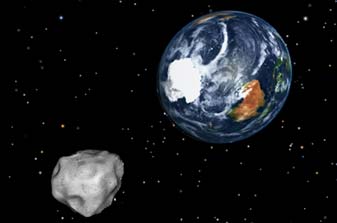In Pic :A simulation of asteroid 2012 DA14 approaching from the south as it passes through the Earth-moon system on Feb. 15, 2013. The 150-foot object will pass within 17,000 miles of the Earth. AP/NASA/JPL-Caltech.
A 325-meter asteroid that will safely fly by the Earth in 2029 and 2036, may strike the planet in the year 2068, scientists have warned. However, the chances of 99942 Apophis striking the Earth are slim with impact odds being about 2.3 in a million, the article published on NASA’s website said.
The near-Earth asteroid has been the focus of considerable attention after it was discovered in December 2004 to have a significant probability of Earth impact in April 2029.
While the 2029 potential impact was ruled out through the measurement of archival telescope images, the possibility of a potential impact in the years after 2029 continues to prove difficult to rule out.
Based on optical and radar position measurements made in 2004-2012, the asteroid will pass the Earth in 2029 at an altitude of 31900 km, give or take 750 km. The altitude is close enough for the Earth’s gravity to deflect the asteroid onto a trajectory that brings it back to an Earth impact during its next flyby.
Such impact trajectories require Apophis to pass the Earth at a precise altitude, known as a keyhole, in 2029 en route to a subsequent impact. “The new report, which does not make use of the 2013 radar measurements, identifies over a dozen keyholes that fall within the range of possible 2029 encounter distances,” reads an article prepared by scientists led by Steve Chesley and Davide Farnocchia from Jet Propulsion Laboratory, California Institute of Technology, Pasadena.
The uncertainty in predicting the asteroid’ s position in 2029 is completely dominated by the so-called Yarkovsky effect, a subtle non-gravitational perturbation due to thermal
re-radiation of solar energy absorbed by the asteroid. Notably, the potential impact in 2036 that had previously held the highest probability has been effectively ruled out
since its probability has fallen to well below one chance in one million.
“Only one of the potential impacts has a probability of impact greater than 1-in-a-million, there is a 2-meter wide keyhole that leads to an impact in 2068, with impact odds of
about 2.3 in a million,” scientists said in the article.






Leave a reply